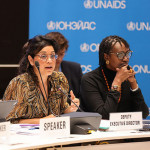The number of young people living with HIV around the world is falling, according to a Joint United Nations Programme on HIV/AIDS (UNAIDS) study presented Tuesday, July 20, at the XVIII International AIDS Conference (IAC), taking place July 18 to 23 in Vienna.
One of the key goals of the 2001 United Nations Declaration of Commitment was to lower by 25 percent the number of young people living with HIV by 2010. To measure progress toward that goal, UNAIDS regularly assesses data from around the globe.
To determine recent progress toward the UN goal, Eleanor Gouws, MSc, MPHc and her colleagues from the Epidemiology and Analysis Division at UNAIDS in Geneva analyzed data from 30 countries invited to participate in an international HIV prevalence study. Gouws included data from sites that regularly contributed data between 2000 and 2008, and from national population-based surveys and HIV testing data from each country.
Gouws found that at least seven countries have met the UN goal already, with declines in the number of HIV-positive young people, ages 18 to 24, by 25 percent or more. These countries included Botswana, Côte d’Ivoire, Ethiopia, Kenya, Malawi, Namibia and Zimbabwe. Three other countries also had significant declines, but only in a portion of the population: Women in Zambia saw at least 25 percent reductions in prevalence, as did men in South Africa and Tanzania. While six other countries are making steady progress toward the goal, five countries are not expected to reach 25 percent reductions by 2010.
Another hopeful sign is that eight of the countries with significant reductions in HIV prevalence also had reductions in sexual risk behavior among young people. “HIV prevalence among young people has been declining in the majority of countries, accompanied by changes in sexual behavior,” Gouws stated. “This suggests that [the number of new HIV infections] is falling in these countries, possibly as a result of prevention programs.”
“Programs need to be further improved and expanded,” Gouws concluded, “while more data and further analyses are needed to understand the associations between programmatic efforts, behavior changes and changes in HIV prevalence and incidence.”
Advertisement
Advertisement
Advertisement






Comments
Comments